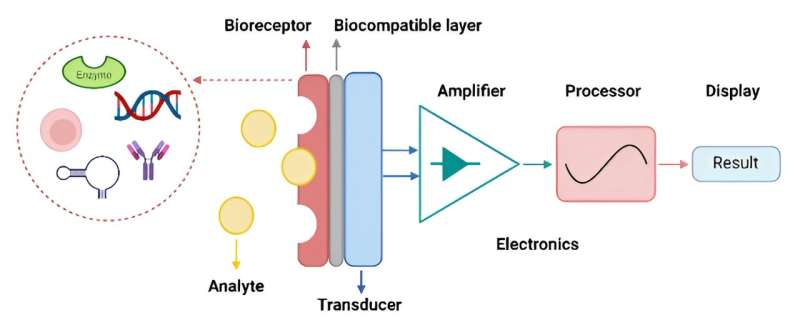This article has been reviewed according to Science X's editorial process and policies. Editors have highlighted the following attributes while ensuring the content's credibility:
fact-checked
proofread
Wireless biosensors could relieve health care system burden

A wireless biosensor, developed by a Malmö University researcher, enables a more patient-controlled system whereby infections can be detected much earlier through smart catheters, smart diapers or wound dressings.
"Imagine that you have a diaper with a sensor that, when exposed to urine, can detect the presence of bacteria in the bladder; the patient can measure and monitor the infection themselves. It will save both time and money because it eliminates a lot of unnecessary doctor's appointments," says Atefeh Shafaat, who recently defended her thesis, "Development of Wireless Biosensors Integrated into the Radio Frequency Antenna (RFA) for Chipless and Battery-less Monitoring of Biological Reactions."
She believes the potential applications of wireless biosensors are huge and will revolutionize the way we monitor our health and various diseases. However, the function of this technology requires reliable sensors that are user-friendly, and require neither traditional integrated circuits nor bulky batteries.
"This makes the biosensors smaller and lighter and the whole system more flexible. We have used a standard RFA tag (a similar technology that can be used, for example, to electronically open doors) with the chip removed. The chip is normally used to store, protect and process data but our system is just for recording and transmitting, so these functions are not needed," explains Shafaat.
The fact that it is battery-free means that measurements cannot be made using, for example, Bluetooth, which otherwise has a longer range than this technology. Instead, the tag is powered by induction where the mobile phone transfers electromagnetic radiation to the tag. As the mobile phone is the reader, it must be within five centimeters to make contact.
Shafaat explains, "Silver, which is conductive, is part of the tag antenna. When we have a certain type of reaction, the silver is converted to silver chloride, which is not conductive; this means that the antenna circuit is opened or broken. The presence of specific analyte repairs the antenna and changes the characteristic frequency which will then lead to the wireless sensing of biological reactions."
In addition to wireless detection of glucose in whole blood samples, the proposed setup has also been tested for wireless monitoring of medically relevant microbial biofilms in wound fluids.
"Unnecessary removal of dressings to check the infection increases the risk of contamination of the wound. Using this technology to detect the infection at an early stage makes treatment much easier," adds Shafaat.
More information: Atefeh Shafaat, Development of Wireless Biosensors Integrated into the Radio Frequency Antenna (RFA) for Chipless and Battery-less Monitoring of Biological Reactions. mau.diva-portal.org/smash/get/ … 08301/FULLTEXT01.pdf



















